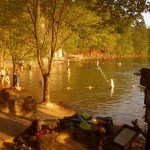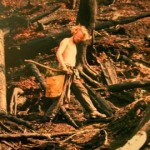Hmmm, history starts when one chooses and as one gets older that becomes more and more of a quandary. I was, like most people born, at a very young age. My British born father and Carolina Scots mother were scientist and nurse respectively. I was the last of three children with a sister and brother who had already divided up the family territory by the time I arrived. I went through an immersion style education that created a life long love for science and the natural world, and when I say immersion I mean it as I was taught how to swim in Walden Pond.
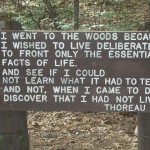 Walden pond is where Thoreau went to live deliberately, face the essential facts of life, and learn from nature. I can testify that if you soak there you can be imbued with some of Thoreau’s magic.
Walden pond is where Thoreau went to live deliberately, face the essential facts of life, and learn from nature. I can testify that if you soak there you can be imbued with some of Thoreau’s magic.
With a mother who had been raised as a share-croppers daughter, one of 9, we didn’t need today’s notions of being locavores or organic foodies. Being a farmers daughter mum had always tended gardens of all varieties from vegetables to flowers. Some of my fondest memories come from being at her side grazing on whatever was ready to eat right out of the ground, perhaps with just a quick wipe to remove the dirt from a baby carrot. More memories include sitting with a fishing rod beside the Concord Bridge, canoeing the lakes of the Adirondacks, and sledding down Bunker Hill, all were lessons in life and history.
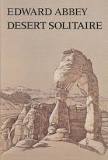 Later as a teenager living out West in the red rock country, becoming a mountaineer and desert rat, courtesy of the fact that my first car was a beat-up old 1958 jeep. I have to admit being inspired by Edward Abbey who haunted the same jeep trails and canyons that I loved. This prepared me for a life long career as an ecologist and conservationist.
Later as a teenager living out West in the red rock country, becoming a mountaineer and desert rat, courtesy of the fact that my first car was a beat-up old 1958 jeep. I have to admit being inspired by Edward Abbey who haunted the same jeep trails and canyons that I loved. This prepared me for a life long career as an ecologist and conservationist.
When the wilderness of the West began to feel less like wilderness, the wilds and the mountains and the call of the north beckoned. With canoe on the roof of my old VW I immigrated to Canada and began climbing the peaks of the Canadian Rockies, paddling the wilds of the Nahanni, Bowron, Tweedsmuir, and sea-kayaking and sailing the Pacific coast from California to Alaska.
For years I carried my bible with me, it was Horace Kephart’s “Camping and Woodcraft.” One of his best lessons that has served me well in both cooking and life is, “never name a dish before it is served.”
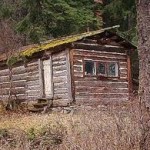 Around the start of the 1970’s I found myself living in a tiny log cabin of 12ft. x 18ft on the shore of Kootenay Lake. Having the 6’2″ mountaineers frame it wasn’t long before I tried falling trees in the local world of logging.
Around the start of the 1970’s I found myself living in a tiny log cabin of 12ft. x 18ft on the shore of Kootenay Lake. Having the 6’2″ mountaineers frame it wasn’t long before I tried falling trees in the local world of logging.
At one point I was being taught by an experienced native faller, who was my cut block partner. We were living and working in the cold of January in a rough logging camp 40 miles from the nearest town in the far northern reaches of British Columbia right up against the Rocky Mountains. The bunkhouse was heated by a tin “Airtight” wood stove and lights kerosene lamps with wicks. Outside at night, the thermometer would drop to 40 below zero.
One night I found again the power of words in reading a book by Gary Snyder out loud. It ruined logging for both of us as Jack my native mentor said. The phrase from the book that stopped both of us in our tracks was something like, “I once knew an Indian faller who had to quit because he could no longer bear hearing the trees scream.” By the end of the next day, he and I agreed we heard the trees screaming all day as our chain saws cut into them. Felling trees was what we “back to the landers” did to make ends meet, or planting trees for way less money but no screams.
About as soon as I made it through the first week of tree planting I could tell it was not rocket science rather plant ecology, something I was educated in and I made my way to the local forest service office and asked to see the tree planting contract announcements. Looked simple enough just make a bid, hire a bunch of hippy friends, buy supplies, and camp right on the planting site.. easy money and the birth of a company we called Coast Range. Twenty years later the company was sold to investors but it still plants trees today.
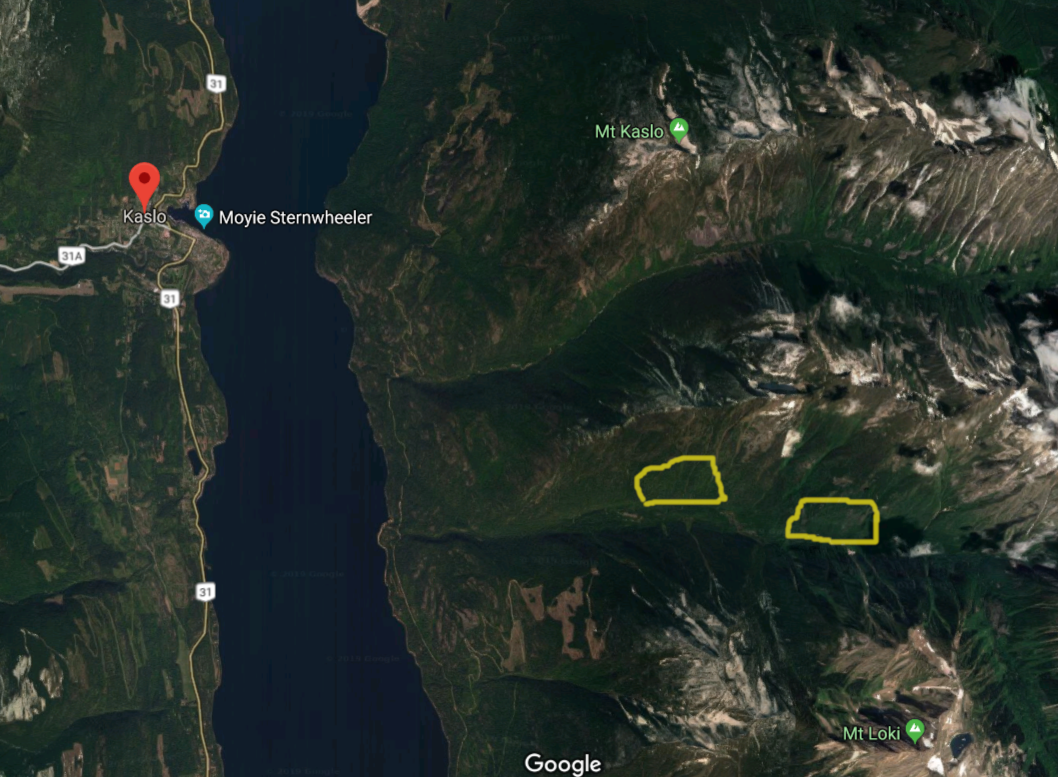
The areas outlined in yellow were my first tree-planting site some 46 years ago. Today there is a healthy forest growing instead of a burned barren waste-land.
Somewhere in the tree planting days, I became friends with a professor of plant ecology who also had an ecology consulting firm. He needed some young blood to implement his expertise in figuring out how to replenish and restore damaged ecosystems and we became partners. Studying and fixing damaged lands was some of the work with a bit of fun such as surveys of exotic areas to be preserved and protected as Ecological reserves was another. Frequently I was found parked over a lab bench in the university herbarium delighting in the taxonomy.
One day a call came from the provincial cabinet, the Minister of Energy, Mines, and Petroleum Resources had been asked in question period what his ministry was doing about damaged landscapes associated with the mining and petroleum world of British Columbia.
We took the job to study the records and I was sat down amidst decades of files and left to come up with some sort of report. It was a long time reading and then a dumbfounding time trying to figure out how to report on it. Fortunately, my daughter was in kindergarten and when I read the simple report card showing what a kindergarten kid could be reported on I saw had an epiphany.
The next day I set about writing a kindergarten level environmental compliance report on every mining company, gravel pit, oil and gas operator in the province. None was anywhere beyond kindergarten level which had totally boggled me. Once I realized that fact I could do something.
The cards simply bore the name and permit number and simple description of whether there was a reclamation bond or not and what was the degree of potential environmental problems on a scale of 1-5. Almost no bonds existed, the highest bond in the province insuring that the operator would do the right thing by the environment or forfeit the bond, was $5000. The engineers who were running things weren’t what you might say “keen” on environmental protection.
Upon depositing the box of report cards on the Cabinet table in front of Premier Bennett I handed a few to each of the cabinet ministers explaining the surprising report format. After a few moments of explanation, the premier barked out, OK smart ass now that you’ve shown we’re remiss in our management you fix it.
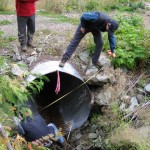 I took the job. The fixing was everything from prescribing that gravel pits ought to have drainage ditches that flowed into settling ponds before the fines made it into the creeks and rivers and messed up the gravel. To prescribing mixtures of birdsfoot trefoil and creeping red fescue to grass over disturbed mine road cuts.
I took the job. The fixing was everything from prescribing that gravel pits ought to have drainage ditches that flowed into settling ponds before the fines made it into the creeks and rivers and messed up the gravel. To prescribing mixtures of birdsfoot trefoil and creeping red fescue to grass over disturbed mine road cuts.
One task was pointing our which culverts on which roadway stream crossings were too small or badly placed and were blocking the fish from crossing the roads. The chief of mine roads in the province, Phil, was an avid fly fisherman so it was easy to get his attention and help.
I just had to organize a few road inspection trips with fly rods in the back of the truck. Once he saw his fish were being impacted by his roads he moved heaven, but mostly earth to fix the problem. Thus was born another chapter in my life of fixing the damage to Nature that our kind has wrought.
Somewhere in this passage of time my children were born, wives and I decide to go separate ways, and I keep living a life inspired that comes from being steeped in Walden’s pond, dried into Edward Abbey’s desert rations, and gathering the personal stories of doing something for the earth that I can now share on this blog.
Ocean Pasture Science Under Sail On A Century Old Baltic Schooner.
Jump forward a few more decades and here I am still walking the walk instead of talking the talk out there restoring trees and seas with the sweat of my own brow.
Soon I’ll be posting a television documentary program here that I wrote, produced, and directed in the late 80’s. It’s titled, The New Environmentalists, and tells the story of environmental scientists and managers who work on the inside, within industry. They go to work every day and do the right thing. That right thing is usually just doing something about the earth, trying to make it a better place.
Walking the walk is far more important than talking the talk.
There is much more of course but you’ll have to buy the book.
Read my blog at www.russgeorge.net









